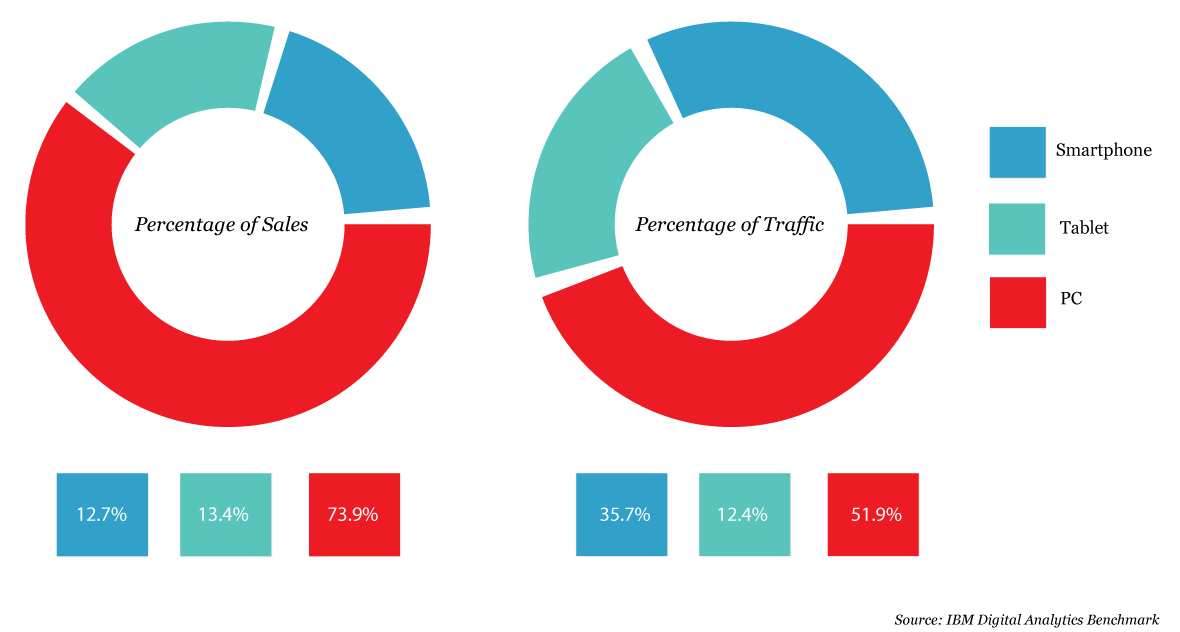
Mobile use growing in e-Commerce
Only recently the level of traffic for e-commerce sites has dramatically shifted. The shift? Mobile devices are driving e-commerce traffic. Nearly 50% of online retail traffic is coming from mobile. The breakdown of that figure is this: 51.9% comes from PCs, 35.7% from smartphones, and 12.4% from tablets.
One interesting point on the above to note is that smartphones are generating more online retail traffic than their bigger counterpart, the tablet. The reason for this might have something to do with the fact that the average user will have her smartphone with her almost at all times, whereas the size of tablets means they are, like laptops, used primarily at home. Yeah, they’re technically mobile devices, but they’re still heavy and cumbersome to lug around.
There are many reasons why this shift has happened, all of which stems from the very simple fact that mobile technology is getting better (and bigger). As mobile technology, namely smartphones, become more capable of fulfilling the tasks for which PCs and laptops have previously been responsible, it’s only natural that our online shopping habits would reflect this transition.
Nevertheless, despite that, all this online retail traffic is coming from the mobile, in the case of actual online purchases made, PCs and laptops remain at the head of the pack.

People are browsing on mobiles (and very possibly while they’re on the go, not in the comfort of their homes), but still following through with purchases from devices sporting bigger screens... which isn’t a huge surprise. For one thing, people don’t use one device in isolation from others. We watch television while we browse the Internet on our laptops, while we send texts on our smartphones while we play games on our tablets. We sometimes do one single thing across different devices at the same time. It’s how the modern technology consumer functions, but in the case of online retail purchases, where is mobile faltering?
Old Habits Die Hard
One of the biggest issues posed for spending on mobile has to do with security. Pressing “buy” at checkout on a mobile phone still seems a little strange. It’s new territory. And accordingly, because it’ still a foreign concept for so many, it will take a period to catch on. For now, PCs and laptops are more widely trusted than mobile.
Another issue has to do with the very simple fact that buying stuff is just easier on laptops and PCs. When you’ve got to punch in all your shipping details and credit card numbers and usernames and so on, doing so on a mobile phone or tablet becomes tiresome and downright annoying. I mean, how many times does the box in which you’re meant to put your phone number just disappear after the second digit? Indeed, new and improved apps are starting to change this landscape, making it far easier to make purchases on smaller, mobile devices. But for now, and for the most part, it’s just more comfortable punching in these details on a keyboard. This point, however, reveals the key to the oncoming tipping point.
New apps are coming together with new-ish technologies. Pretty much all new smartphones currently being made come packed with inbuilt NFC technology. Wearable devices, too—the next generation of mobile devices—are being made with quick-pay, NFC technology in mind. In short, mobile devices are making paying for almost anything—online and offline—a helluva lot easier. This coupled with the fact that app developers are amalgamating these new-ish technologies with their apps—a great example is finger-swipe security for quick payments online— it’s only inevitable that mobile will reach complete e-commerce dominance in a future that will dawn quicker than we can say mobile is the new black.
